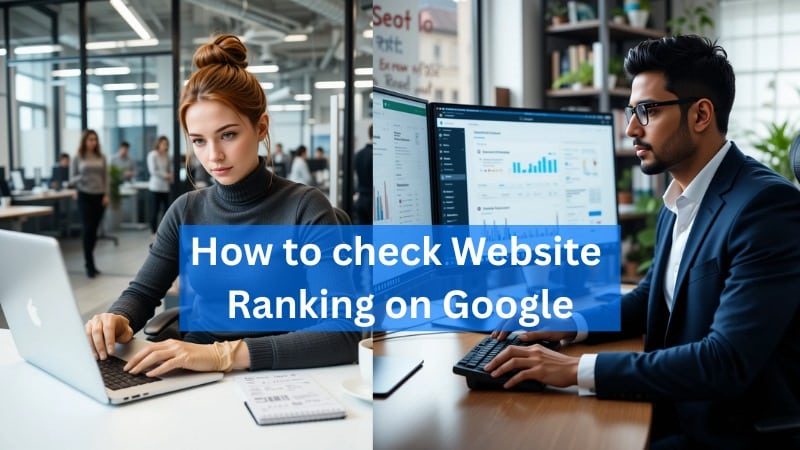
How to Find Out Where My Website Ranks on Google| Free & Easy Methods
Does your website even show up when someone searches on Google?
You’ve worked hard—wrote good content, used keywords, maybe even tried some SEO tools.
But when you Google your keyword, your site is nowhere to be seen. It feels like all that effort disappeared. You’re not the only one.
Many website owners have no idea where they stand in search results. And without knowing your rank, fixing what’s not working is hard.
Hence, that’s why in this guide, I’ll show you
how to find out where your website ranks on Google—step by step, with free tools anyone can use.
Moreover, this guide explains how to check your website’s ranking on Google, why it matters, and how to improve it.
Whether you’re a beginner or an experienced webmaster, you’ll find actionable steps to monitor and boost your site’s visibility.
Let’s figure out where your site stands—and how to move it up.
Why It’s Important to Know Your Google Ranking_ SERP Position
First, understanding your website’s position on Google’s search engine results pages (SERPs) is crucial for driving traffic and growing your online presence.
- Impact on Traffic: Higher rankings (especially on the first page) lead to more clicks. Studies show that the top 3 results get over 50% of clicks.
- Visibility Equals Clicks: Ranking higher increases brand exposure, even if users don’t click immediately.
- Role of SEO: Search engine optimization (SEO) improves rankings by aligning your site with Google’s algorithms, focusing on content quality, keywords, and technical performance.
- Business Growth: For e-commerce or service-based sites, better rankings translate to more leads and sales.
Manual Methods To Check Your Website Ranking_ Search Engine Position Tracking
You can check rankings without tools by performing searches directly on Google, but it requires careful steps to avoid biased results.
- Use Incognito/Private Mode: This prevents personalized results influenced by your search history or cookies. Open a private browsing window in Chrome, Firefox, or Safari.
- Non-Personalized Search: Add &pws=0 to the Google search URL to disable personalization further.
Location-Specific Searches: Rankings vary by location. Use tools like Google’s Ad Preview Tool or append near=[city] to your search query for local results.
- Pros and Cons:
- Pros: Free, quick, and no account needed.
- Cons: Time-consuming for multiple keywords, doesn’t track historical data, and may miss mobile or local variations.
What Does &Pws=0 Mean| How to Find Out Where My Website Ranks on Google
So, this is a Google search URL modifier you can add to the end of a search query to turn off personalized results.
What It Does:
When you search for something on Google, it often shows personalized results based on your:
- Search history
- Location
- Click behavior
- Logged-in Google account
By adding &pws=0 at the end of your search URL, you’re telling Google:
“Don’t personalize the results—just show neutral, non-biased ones.”
Example:
- Original search URL:
https://www.google.com/search?q=best+seo+tools - With non-personalized:
https://www.google.com/search?q=best+seo+tools&pws=0
What Does Near=[City] Mean?
It helps you get location-specific search results, which is super useful if your website targets local areas.
What It Does:
Adding near=city tells Google to simulate a search from that city, so you can check how your site ranks in that location.
Example_ How to Find Out Where My Website Ranks on Google
So, if you’re in New York but want to see results from Los Angeles, search:
best pizza near=los angeles
Or use it in tools that allow location modifiers.
In Short:
- &pws=0 = No personal data affects the search
- near=[city] = Location-based results for checking local SEO
Best Free Tools to Check Website Rank on Google
Free tools provide an efficient way to check rankings without manual effort. Here are the top options:
Google Search Console:
Features:
Shows average ranking positions for your site’s keywords, impressions, and click-through rates.
How to Use:
Set up your site, go to the “Performance” report, and filter by queries or pages.
Limitations:
Doesn’t show exact rankings for all keywords; data is averaged.
SERP Checkers:
SERProbot:
Free, checks rankings for specific keywords across locations and devices.
WhatsMySerp:
Offers bulk keyword checking with a clean interface.
Ubersuggest:
Provides ranking data alongside keyword suggestions.
Limitations:
Limited free checks per day; less accurate for low-volume keywords.
- Tip: Combine Google Search Console with a SERP checker for a fuller picture.
How to Track Keyword Rankings_ How to Find Out Where My Website Ranks on Google
Monitoring rankings consistently helps you understand trends and measure SEO progress.
- Why It Matters: Rankings fluctuate due to algorithm updates, competitor changes, or your own optimizations.
- Free Tools:
- Google Search Console: Export performance data monthly to track changes.
- SERPWatcher (limited free plan): Tracks keyword positions daily.
- Paid Tools:
- SEMrush: Tracks rankings across devices and locations with historical data.
- Ahrefs: Monitors keyword performance and competitor rankings.
- Setting Up Alerts: Tools like SEMrush or SERPWatcher can notify you of significant rank drops or gains.
- Best Practice: Track 5-10 high-priority keywords weekly and review monthly trends.
Paid Tools That Give More Accurate Results
For deeper insights, paid tools offer advanced features and precision.
- Ahrefs:
- Features: Tracks keyword rankings, mobile vs. desktop, historical data, and competitor analysis.
- Cost: Starts at $99/month (as of 2025).
- SEMrush:
- Features: Position tracking, local SEO, and SERP feature analysis (e.g., featured snippets).
- Cost: Starts at $119/month.
- Moz Pro:
- Features: Keyword tracking, on-page SEO suggestions, and rank history.
- Cost: Starts at $99/month.
- Why Pay?: Paid tools provide granular data (e.g., ranking by city, device type) and integrate with other SEO tasks like backlink analysis.
What Affects Your Website’s Ranking on Google?
Several factors determine where your site ranks. Understanding these helps you prioritize improvements.
- On-Page SEO: Keyword-optimized titles, meta descriptions, headers, and content relevance.
- Backlinks: High-quality, relevant links from authoritative sites boost rankings.
- Content Relevance: Fresh, in-depth content that matches user intent ranks higher.
- Mobile-Friendliness: Google prioritizes mobile-optimized sites, especially for mobile searches.
- Page Speed: Faster-loading pages improve user experience and rankings.
- SERP Features: Featured snippets, knowledge panels, or local packs can push organic results lower.
Local SEO: For businesses, Google My Business optimization and local citations impact rankings.
How to Improve Your Google Rankings After Checking
Once you know your rankings, take these steps to climb higher
- Keyword Optimization:
- Target long-tail keywords with lower competition.
- Use tools like Google Keyword Planner or AnswerThePublic to find relevant terms.
- Technical SEO Audit:
- Fix broken links, improve site speed (use Google PageSpeed Insights), and ensure HTTPS.
- Submit an updated sitemap via Google Search Console.
- Building Backlinks:
- Guest post on reputable sites or earn links through high-quality content.
- Use Ahrefs to find link-building opportunities.
- Updating Old Content:
- Refresh outdated posts with new data, images, or keywords.
- Add internal links to boost page authority.
- Engage with SERP Features: Optimize for featured snippets by using question-based headers and concise answers.
Understanding SERP Features and Local SEO
- SERP Features: Rankings can be affected by featured snippets, “People Also Ask” boxes, or image carousels. Optimize content to appear in these (e.g., use structured data for rich snippets).
- Local SEO: For location-based businesses, claim your Google My Business profile, collect reviews, and ensure consistent NAP (Name, Address, Phone) across directories.
Frequently Asked Questions
How often do Google rankings shift?
Daily or weekly, depending on algorithm updates or competitor moves. Check weekly to stay sharp.
Can I rank high without backlinks?
Tough but doable. Nail on-page SEO and content for low-competition keywords to sneak up.
How long till I see ranking jumps?
New sites take 3-6 months; quick fixes might pop in weeks. Patience plus hustle equals results
What’s up with mobile versus desktop ranks?
Google loves mobile-first sites. Optimize for phones or your rank tanks on both.
Why can’t I find my site when I search for how to find out where my website ranks on Google?
High competition or weak SEO might bury you. Use tools like SEMrush to diagnose and fix.
Want to know how to find out where your website ranks on Google? Discover free tools and simple steps to track your SEO performance like a pro
